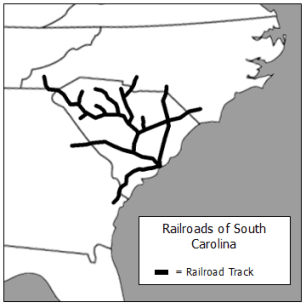
Test 7 Review (SC Quiz #1-3)
Quiz by Michael Jenkins
Feel free to use or edit a copy
includes Teacher and Student dashboards
Measure skillsfrom any curriculum
Measure skills
from any curriculum
Tag the questions with any skills you have. Your dashboard will track each student's mastery of each skill.
With a free account, teachers can
- edit the questions
- save a copy for later
- start a class game
- automatically assign follow-up activities based on students’ scores
- assign as homework
- share a link with colleagues
- print as a bubble sheet
30 questions
Show answers
- Q1How did the development of these train routes impact South Carolina?The construction of these train routes destroyed valuable farmland and crippled the state economy.Agriculture and textile businesses were denied the resources to industrialize.Cities grew around important train stops as they became centers of business.Northern businesses that owned these train companies helped support equal rights politicians in the state.30s
- Q2Why were many northern businesses attracted to the idea of building factories in South Carolina after Reconstruction?Business owners felt it was acceptable to invest in the South as African American rights increased.Business owners felt that it was morally wrong to use the child labor that was common in the North.The low wages and lack of union protection greatly lowered the operating costs.The many coal and iron sources in the state made it a great location for industrialization.30s
- Q3What prevented mill workers in South Carolina from forming unions to improve their working conditions?Political leaders in South Carolina supported mill owners in their fight to prevent the formation of unions.Mill workers lacked support from national unions who refused to help textile workers.There were not enough mill workers in South Carolina to justify the formation of a union.There was little public support for the formation of unions because mill workers made high salaries.30s
- Q4How did South Carolina's industrial development after the Civil War compare to the rest of the nation?South Carolina lagged behind the rest of the nation in industrial development but saw growth in the textile industry.South Carolina resisted the growth of all industry and stayed economically different from the other southern states.South Carolina was on pace with the rest of the nation in terms of economic and manufacturing development.South Carolina was far more advanced in its mining, textile, and meat-packing industries.30s
- Q5How did the government's laissez-faire policies promote industrialization in the United States and South Carolina after Reconstruction?A lack of regulation allowed industry to grow with very few restrictions.Government loans increased the number of businesses in the United States.Strict regulations about working conditions encouraged more immigrants to seek jobs in America.Laws encouraging competition between businesses led to lower prices and higher quality products.30s
- Q6Why did mill-owners prefer to hire workers like the one in this photograph?Immigrants did not have to be paid as much as native-born workers.Younger children were more prone to workplace accidents.Younger children had smaller hands that could quickly tie broken threads.Females tended to be more focused on their work than males.30s
- Q7What industry was supported by natural deposits of phosphate in the Beaufort area of South Carolina?iron and steel productionthe railroadscommercial fertilizertextile mills30s
- Q8Who did government tend to support in labor disputes in the late 19th century?union organizersfactory ownersworkersfreedmen30s
- Q9What is the main reason that mill workers in South Carolina were unable to improve their conditions and salaries?Union organizers were fired and the labor movement was fiercely resisted by mill-owners.Diseases like tuberculosis and brown lung killed off workers before they could organize.Most of the laborers were children and unable to organize themselves.Workers were well treated and did not need to bother trying to improve their situation.30s
- Q10How did the life of mill workers in South Carolina compare to those in northern states?Mill workers were generally treated with more dignity and allowed to collectively bargain.They worked similar hours, but made less than half of what northern workers earned.They made less money, but worked in more favorable conditions.There was no child labor in South Carolina, which meant fewer workplace accidents.30s
- Q11Why did the price that South Carolina cotton farmers received for their crops fall in the late 19th century?It became easier to pick cotton using machines.Demand increased.The worldwide supply increased.There was no longer slave labor.30s
- Q12What was the aim of the crop lien laws in the South after the Civil War?to further segregate black and white farmers from each otherto maintain the nutrients in the soil by mandating rotation of cropsto allow banks to claim future crops from those that owed moneyto allow farmers to borrow money with no interest from banks30s
- Q13After the Civil War, what role did cotton production play in South Carolina’s economy?Cotton was no longer a cash crop since Europeans relied on cotton imports from Barbados.Cotton production was very profitable, and most sharecroppers earned high wages.The crop lien system prevented many cotton farmers from earning large profits.The cotton gin allowed cotton to be produced efficiently even without a large labor force.30s
- Q14How did the increased supply of cotton across the world impact the economy in the South in the early 1900s?The use of cotton decreased and the economy dipped.Cotton prices increased and the economy boomed.The demand for cotton increased and the economy boomed.Cotton prices dropped and the economy decreased.30s
- Q15This cycle shows a system put in place in the South in the late 19th century. Based on this cycle, the crop lien system was most economically advantageous for what group?large landownerssmall farmersindustrial workersbankers and creditors30s
